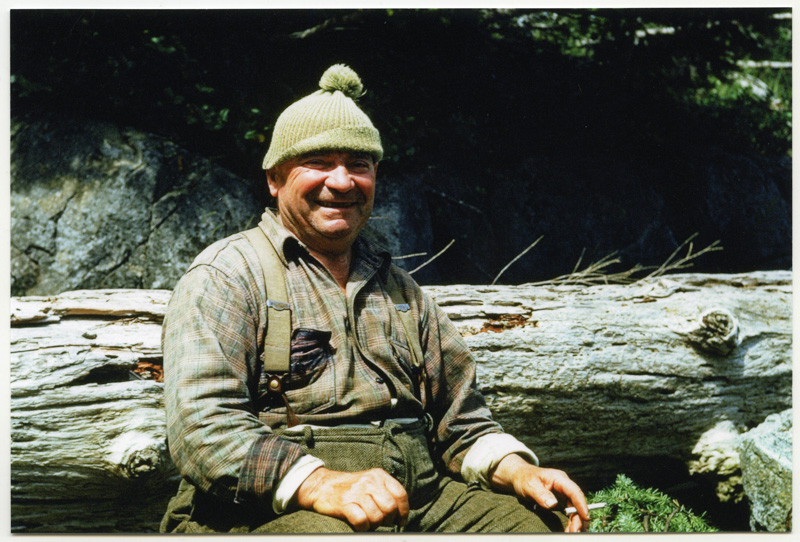As someone who has always been fascinated by pioneer life, I have spent much of my time on Cortes exploring old homesteads – digging up old bottles from the roots of trees, trying to determine what sort of structure a couple of old mossy planks once formed, and writing stories about the lives I imagined the people who used to inhabit those spaces lived.
Being such a person, of course, I am familiar with Carrington Bay Park. There you will find a maze of old logging roads littered with rusty vehicles abandoned over fifty years ago. Carrington was a hot spot for early settlers, hosting several homesteads. Among the evergreens, you will see the occasional grassy clearing dotted with old fruit trees. If you feel comfortable going off path, you will likely bump into further signs of the lives once lived there. The Peter Police homestead is one such place. Down a muddy trail, past a broken-down truck, you will find a bay with a grassy shoreline. There grow old fruit trees (the pear trees still produce in September and Islanders collect them), a nut tree, and logs marking where there was once a building beside a stream that trickles down to the lagoon. By the stream, grapevines and wild rose bushes. The lagoon itself is mushy sand bedding small crustaceans. It’s a beautiful location and one can only imagine how incredible it would have been to inhabit.
When visiting this beautiful little bay in the past I couldn’t help but wonder about the people who once occupied the space. Of course, one thinks of the settlers; but who was there before them? Although we have no records of Indigenous people inhabiting the bay, I imagine they were familiar with it. I can see them stopping to eat or rest when passing by in their travels.
Close to the outlet of the lagoon was the home of Captain George and Mary Gertrude Sparrow. They lived there with their three children for five years. The two older children, John and Anne, spent much of their time in a dugout canoe made for John by some of the Klahoose people. I imagine the Sparrows were good friends with them and perhaps had them over for dinner at the Carrington Bay farm. After these visits perhaps they stopped by at nearby Chicken Island which was the burial place for one of their female ancestors.[9]
For the sake of today’s article, I focus on Peter Police, the man who came to occupy this spot so rich in history, past lives, and experiences of joy and sadness alike. Who was this man? Who was Peter Police?
Working at the Cortes Museum has allowed me to explore this question; this is what I found.

Peter (Antonio[2]) Police was born June 29, 1886, in Carlei, Italy[3] (perhaps a misspelling of Carolei).
Peter migrated from Italy at the age of thirteen, coming out to an uncle in New York. Learning of homestead land in the Peace River Block he saved his pennies and moved to Canada. After a bitterly cold winter he decided even war might be preferable, so, he enlisted in the Canadian infantry. He suffered a severe wound in service. As Peter told it, One shell blew Peter up and, instantly, another shell blew Peter down. Peter was sent back to Canada (where)[1]
… a Montreal doctor told him he’d have to have surgery. Peter said that first he wanted to see his mother. He looked at a map of Canada and decided Haida Gwaii was the farthest away he could get, so he told the doctor that’s where his mother lived. Peter fished for a few years at Haida Gwaii. … In 1923 Peter married Violetta Woodhead, but the union ended within three weeks, so he never tried marriage again. “I will not be responsible for the debts incurred by my wife, Violet Police,” Peter announced in the Daily Colonist in January 1924, “who has left my bed and board.”[2]
Peter’s Home

On August 22, 1925, Peter traded his fishing boat for $1 for a crown grant of 103 acres from a Frenchman, Jean Brissonne. The land was located at the upper end of Carrington Lagoon.[2][4][5]
Children there remembered Peter’s homestead as a beautiful place to go. There were lots of fruit trees to climb and fruits to pick in season. He kept sheep to mow the orchard grass. His creek had a rock wall dam where Peter kept trout he caught up at the lake in the pond behind the dam. He’d make fishing lines for the children to fish in his pond then cook the fish they caught for their supper.[9]

In 1943, Peter put his homestead up for sale in the newspaper. At the time, he had 144 acres, 5 of which were cleared and fenced. It was located two miles from the school and four miles from the store and post office. The asking price was $2200 cash.[8]
It seems strange Peter would sell his homestead. It was in a beautiful location, and he seemed very settled. He was living alone at the homestead and as you can see in the photo above, it was very large. At the time, Peter was about sixty. He had been living with a debilitating war injury for years. I imagine Peter’s lifestyle became too much for him to maintain and he chose to move where he could start over in a less ambitious manner. Peter moved to the Gorge, which was less remote. There he would have more support from neighbours, especially if he became ill or wounded.

Peter moved to the Gorge Harbour in 1948.[7]

I am unsure how Peter afforded to start over in the Gorge, as his homestead didn’t sell; “A number of different logging outfits used the house for a few years following his move.”[7]
Remembering Peter
I am going to be bold and say that Peter Police is a household name to Cortes Islanders. His homestead is one of the most well known, and his name is distinctive. However, not much is known about Peter. When his name is mentioned, old timers generally say something along the lines of “he was quite a character,” but in my research the documentation of this character was scarce. Here are the documented memories of Peter which I hope will manage to give you a vague idea of what it was like to know him.
Peter … had an old black horse and, due to Peter’s liberal feeding, the horse was rolling in fat. It was quite a sight to see Peter mounted on his trusty steed, legs sticking straight out wearing a white Panama hat with a bandana floating behind as they ambled out the road to Whaletown.[9]
But … “Peter Police was a real Mr. 5 by 5 – his pant size was 48 waist and 24 leg.”[1]. So, “Later he used a cart pulled by his horse, then an old truck.”[9]
Although Peter claimed he was not interested in marriage after his failed union, perhaps the reason he remained single for life was less by choice than he let on.
… [Peter] decided he wanted a partner and mother wrote a letter (he was … not able to read or write English) to the province requesting a partner. Great day came when she arrived. She stayed all of two weeks and returned to Vancouver.[6]
Although unsuccessful in love, Peter was not in want for relationships. He was sociable and well-liked by the community and although his homestead was remote he managed to have visitors over frequently.
He was an excellent cook and the soul of hospitality. If Peter saw anyone in his area, he immediately insisted that they come in for a meal … My brother and I had been fishing at Barrett’s Lake and Peter spotted us going home. This meant dinner with Peter, of course. My first encounter. Peter set about preparing dinner – fried chicken, mashed potatoes, biscuits, vegetables and assorted pickles. Delicious! However, we were first given goblets of dandelion wine. I sipped, manfully, on the first one but when Peter came back with the jug and poured a refill, I faltered. Sitting near a fine, flourishing house plant, I managed to pour my wine into the plant pot. A few days later Peter came down to tell my mother about his dying plant and consult her about its demise. – Mary McMillan[1]
Peter was a little superstitious but he made up for it by being a caring soul and friend to all. Philip Major Douglas remembers:
About 15:30 I heard someone calling to me from the trail up by the garden, so I answered and in a few moments Peter appeared. He said he had dreamed of me last night and was worried that I might be ill or hurt so he came over to make sure that I was alright. I took a great liking to Peter the first time I saw him and this incident has endeared him to me a very great deal. He isn’t any too spry and the walk over from his place isn’t an easy one, so I think it was a very fine thing for him to do … My heart was really warmed by his thoughtfulness in coming over.[12]

Other social activities we took part in were group hikes to visit Peter Police because he enjoyed company and he was a good entertainer. – Gladys Reckert[10]
Peter taught my mother how to make home brew beer and also showed her how to pick dandelions when they first came up in the spring and they made a beautiful salad. With olive oil and lemon dressing! … Our families (the grownups that is) had many parties at Peter’s and all of us young ones would be bedded down to sleep in the attic. – Valerie Thomas[11]
Peter’s Death

Peter died at Shaughnessy Hospital in Vancouver, B.C., at 1 p.m. on January 30, 1970, at age 83. The cause of death was a week-long case of bronchopneumonia. Peter is buried in Surrey B.C. at the Victory Memorial Gardens. His death was signed for by the female executor of his will who happens to be his great-niece, Evelyn Mary Russell.[3]
————————————-
Sources
[1] Mary McMillan, Carrington Bay Exhibit, 2009, Cortes Island Museum
[2] Tidal Passages, Jeanette Taylor, 2008, Harbour Publishing Co. Ltd. Chapter Two: Cortes, Marina, Hernando, Twin, Subtle and Mitlenatch Islands, page 115
[3] Royal BC Museum Archives, registration of death
[4] Doreen Thompson fonds, 1-13, Cortes Island Museum Archives
[5] Bertha Reedel Information Files, Cortes Island Museum
[6] Anne (Sparrow) Yates remembers Carrington Bay’s early days (1915-21) in Photographs and Stories Carrington and Coulter Bay, Cortes Island Museum, history album
[7] Photographs and Stories Whaletown and Coulter Bay, Cortes Island Museum, history album
[8] May and Elmer Ellingsen fonds, Cortes Island Museum Archives
[9] Carrington Bay, Cortes Island Booklet Series by Cortes Island Museum
[10] Gladys Reckert, Photographs and Stories Whaletown 1931-1949, Cortes Island Museum, history album
[11] Valerie Thomas in 1999 shares her recollections of Cortes Island during the ’30s in Photographs and Stories Whaletown 1931-1949, Cortes Island Museum, history album
[12] Journal of Philip Major Douglas, October 18, 1948. Cortes Island Museum Archives, Gilean Douglas fonds


4 Responses
Most lovely!! I live on Quadra Island…. My Dad came here in 1924. I just love the History of our area! Very well done!!!
Thanks for your comment Karen! I love local history too. I’m glad I should share that passion with you!
Thanks Natalia,
I too wanted to “know” more of Peter Police. When I moved to Bluejay, the wall were still up on his hewn log house. FYI the dam is still across the creek as well.
Henry
Hi Henry, thanks for the comment! I forget how close Bluejay is to Carrigton. Primo location! I will have to keep an eye out for the dam next time I’m at the homestead.